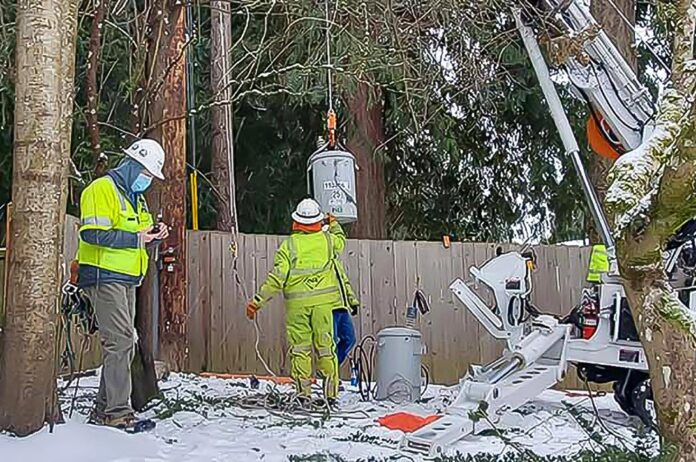
The large winter storm that swept across northwest Oregon over the weekend of Feb. 11-14 not only dumped over a foot of snow in some areas it brought a damaging layer of ice that crushed the local electrical grid.
The storm left well over a half-million people without power throughout the northern Willamette Valley and as far east as Hood River as layer upon layer of freezing rain left sheets of ice coating roadways, trees and power lines. Innumerable trees were were damaged or destroyed, along with the utility poles and other infrastructure, leaving a swath of damage that caused Portland General Electric to call on mutual aid agreements with utility partners from as far away as Montana and Nevada.
PGE President Maria Pope called the storm “historic” and “the worst in 40 years” at a virtual press conference held Wednesday, Feb. 17.
“We tripled the size of our workforce … and worked at historic levels through the weekend,” Pope said. “The staggered effect of these storms caused unique complexity to our restoration refforst, and ice on Sunday (Feb. 14) brought down thousands of trees that further set us back and caused thousands of customers to be out of power.”
Many residents of Washington, Multnomah and Clackamas counties experienced more than one power outage as crews scrambled to repair damaged sub-stations, transmission facilities, downed utility poles and damaged power lines. As crews prioritized restoring power to critical public safety infrastructure, including hospitals and water treatment facilities, residential customers were forced to wait their turn for the lights to come back on.
In Tigard, City public works crews were faced with a series of calamities that, for a short time, left residents in both Tigard and Lake Oswego without a functioning water supply system. According to an email sent to employees by Public Works Director Brian Rager, Friday, Feb. 12, and obtained by Tigard Life, the water intake pump station (RIPS) on the Clackamas River that serves both cities lose electric power as the storm reached its full fury. Further, the backup power feed from PGE’s system also went down. “Without fresh water from the Clackamas River, the water treatment plant (WTP) cannot process clean water for LO and for Tigard,” Rager’s email stated.
Because the water intake facility on the Clackamas River is in Lake Oswego and feeds that city with water before it reaches Tigard, the system was built with the ability to reverse the flow of water if Lake Oswego was unable to pump or treat water. That capability came in handy this time around, as Tigard called upon the City of Beaverton for assistance, pumping water from Beaverton into Tigard and then Lake Oswego.
On Saturday, Feb. 13, the water treatment plant serving both cities also lost power. So, crews scrambled to find generators with at least 450 kilowatts of power to get both the treatment plant and the intake pump station back up and running. It was an unprecedented real-world test of emergency capabilities, and Tigard City Manager Steve Rymer, on the job for less than a month now, said his crews passed with flying colors.
“A big kudos goes to many people in our public works department,” Rymer said at the Feb. 16 meeting of the Tigard City Council. “We had a power outage in our water treatment plant with the city of Lake Oswego, and, literally, our team worked around the clock working with Lake Oswego to make sure both Tigard and their community had the appropriate water supply. And thanks to our neighbors in Beaverton for making that work, the ingenuity and creativity of everyone involved made sure everyone was safe at all times.”
Rager was equally effusive in his praise.
“We were forced to test our partnership with LO, and I think it was a huge success, thanks to the team members of both cities,” he wrote to his employees. “That is the big story in my mind. This tested our teams’ ability to think under pressure, consider system designs and work together to implement plans. I could not be more proud of our group.”
When it came to area roads, they were largely passable by Tuesday, Feb. 16, except for some lightly traveled side streets. But even then, the odd vehicle could still be seen in odd positions after having been abandoned during the height of the storm.
It’s unlikely that Washington County residents will soon forget this event, which left some residents without power well into the following week and even caused the cancellation of online school efforts for several days.
PGE Utility Operations Director Dale Goodman said that over 130 contract crews were shipped in to assist PGE crews in restoring the hundreds of transmission lines and substations that failed during the storm.
“Every field employee is out there safely working in some of the most dangerous conditions we’ve ever faced in the history of PGE,” Goodman said on Feb. 17. “We have tree limbs, wires down, vegetation issues to clear, and our crews are going through areas that are impassable. They really are working as hard as they possibly can to get power back on for our customers. It was a heroic effort to get our transmission system back up to where it is today.”






















